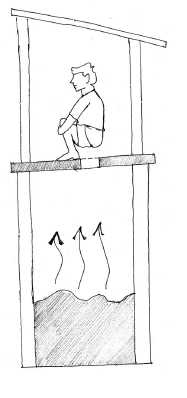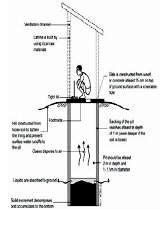<<< Previous
|
|
Next
> >>
|
| SIMPLE PIT LATRINE |
| Goto Technical details |
Overview
This toilet technology is based on collection and storage of excreta. The human excreta is considered as an absolute waste; not as a product that can be treated or reused. These types of toilets are commonly used by the poorer segments in society in the developing countries since they are relatively simple and low-cost toilets.
They are made of a latrine superstructure and a hole for defecation. A pit cover slab can be used to reduce odour and hinder flies. The depth of the pit is usually limited by the groundwater table or rocky underground, but an average of 3m depth is common. The underground of the latrine should be water pervious. No sullage treatment is required. The latrine can be used until it is filled up half a meter below the top. Relocation of latrine is usual after the pit is full. Life time depends on the number of users.
Advantages

This toilet technology is based on collection and storage of excreta. The human excreta is considered as an absolute waste; not as a product that can be treated or reused. These types of toilets are commonly used by the poorer segments in society in the developing countries since they are relatively simple and low-cost toilets.
They are made of a latrine superstructure and a hole for defecation. A pit cover slab can be used to reduce odour and hinder flies. The depth of the pit is usually limited by the groundwater table or rocky underground, but an average of 3m depth is common. The underground of the latrine should be water pervious. No sullage treatment is required. The latrine can be used until it is filled up half a meter below the top. Relocation of latrine is usual after the pit is full. Life time depends on the number of users.
Advantages
- unit can serve one or several households.
- Lowinvestment for construction. Enables constr uction without depending on expert inputs.
- Easy operation and maintenance
- Flies and odour eliminated in VIP latrine
- Design is readily available; local materials can be used
- Potential odour and flies problem in simple pit latrine
- Possibility of groundwater contamination
- Requires re-location of pits once full.
- Re-location of individual leach-pits difficult in densely populated areas
- Space for relocation and/or desludging of pit required
- Functions only if water use is minimal
- Manual desludging poses health hazard
| Rural SanitationTechnology Options. Institute of Social StudiesTrust, [C.eldoc1/d70d/rural-san-tech-option.pdf] |
| Pit latrines [C.eldoc1/d70d/undp1_060913zzz5B.html] |
|
|
<<< Previous
|
|
Next
> >>
|
